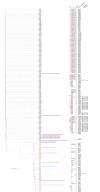Whole-genome phylogenetic analysis of Mycobacterium avium complex from clinical respiratory samples
- PMID: 39792017
- PMCID: PMC11792509
- DOI: 10.1128/spectrum.01600-24
Whole-genome phylogenetic analysis of Mycobacterium avium complex from clinical respiratory samples
Abstract
The Mycobacterium avium complex (MAC) is a common causative agent causing nontuberculous mycobacterial (NTM) pulmonary disease worldwide. Whole-genome sequencing was performed on a total of 203 retrospective MAC isolates from respiratory specimens. Phylogenomic analysis identified eight subspecies and species. M. avium subspecies hominissuis (MAH) was the overwhelmingly dominant species (148/203, 72.9%). The other seven identified species were M. intracellulare subsp. yongonense (18/203, 8.9%), M. intracellulare subsp. chimaera (10/203, 4.9%), M. colombiense (11/203, 5.4%), M. paraintracellulare (6/203, 3%), M. marseillense (5/203, 2.5%), M. intracellulare (3/203, 1.5%), and M. avium subspecies paratuberculosis (2/203, 1%). Significant genetic clustering was observed among MAH isolates. Notably, a large cluster (<12 SNPs) of 76 MAH isolates bearing the same sequence type was observed. The presence of closely related isolates within hospital settings raises concerns about transmission routes with environmental sources potentially playing a significant role. Based on susceptibility breakpoints that are available for clarithromycin, amikacin, linezolid, and moxifloxacin, low rates of clarithromycin (0.5%, 1/203) and amikacin (1.5%, 3/203) phenotypic resistance were observed. While linezolid and moxifloxacin resistance were 25.6% (52/2030) and 46.3% (94/203), respectively. Drug resistance-associated loci were searched for mutations linked to phenotypic drug resistance. Of the entire cohort, only one isolate was found to have a A2059G 23S rRNA (rrl) gene mutation responsible for macrolide resistance.
Importance: Mycobacterium avium complex (MAC) infections are increasingly challenging to manage due to their complex species diversity and varied resistance patterns. This study underscores the genetic diversity within MAC, identifying at least eight species and subspecies among 203 clinical isolates, with M. avium subsp. hominissuis (MAH) being most prevalent at 72.9%. Notably, genetic clustering was observed within MAH and M. intracellulare subsp. chimaera, suggesting potential transmission routes within healthcare settings. Clarithromycin and amikacin resistance was found to be uncommon, aligning with the rarity of resistance-associated genetic mutations. These findings emphasize the need for enhanced infection control measures and routine susceptibility testing to tailor antibiotic therapies effectively.
Keywords: Mycobacterium aviumcomplex (MAC); antibiotic resistance; environmental sampling; nontuberculous mycobacteria (NTM); phylogenetic analysis; transmission dynamics; whole-genome sequencing (WGS).
Conflict of interest statement
The authors declare no conflict of interest.
Figures

Similar articles
-
Diversity and antimicrobial resistance profiles of Mycobacterium avium complex clinical isolates in Thailand based on whole genome comparative analysis.Sci Rep. 2025 Jan 4;15(1):772. doi: 10.1038/s41598-024-84511-z. Sci Rep. 2025. PMID: 39755794 Free PMC article.
-
Heterogeneity among Mycobacterium avium complex species isolated from pulmonary infection in Taiwan.Microbiol Spectr. 2025 Aug 5;13(8):e0030925. doi: 10.1128/spectrum.00309-25. Epub 2025 Jul 7. Microbiol Spectr. 2025. PMID: 40621928 Free PMC article.
-
Genome-scale analysis of Mycobacterium avium complex isolates from Portugal reveals extensive genetic diversity.Infect Genet Evol. 2024 Nov;125:105682. doi: 10.1016/j.meegid.2024.105682. Epub 2024 Oct 20. Infect Genet Evol. 2024. PMID: 39437880
-
Dose response models and a quantitative microbial risk assessment framework for the Mycobacterium avium complex that account for recent developments in molecular biology, taxonomy, and epidemiology.Water Res. 2017 Feb 1;109:310-326. doi: 10.1016/j.watres.2016.11.053. Epub 2016 Nov 24. Water Res. 2017. PMID: 27915187 Review.
-
Genetic diversity and phylogeny of Mycobacterium avium.Infect Genet Evol. 2014 Jan;21:375-83. doi: 10.1016/j.meegid.2013.12.007. Epub 2013 Dec 15. Infect Genet Evol. 2014. PMID: 24345519 Review.
References
-
- Lim AYH, Chotirmall SH, Fok ETK, Verma A, De PP, Goh SK, Puah SH, Goh DEL, Abisheganaden JA. 2018. Profiling non-tuberculous mycobacteria in an Asian setting: characteristics and clinical outcomes of hospitalized patients in Singapore. BMC Pulm Med 18:85. doi:10.1186/s12890-018-0637-1 - DOI - PMC - PubMed
-
- Daley CL, Iaccarino JM, Lange C, Cambau E, Wallace RJ Jr, Andrejak C, Böttger EC, Brozek J, Griffith DE, Guglielmetti L, Huitt GA, Knight SL, Leitman P, Marras TK, Olivier KN, Santin M, Stout JE, Tortoli E, van Ingen J, Wagner D, Winthrop KL. 2020. Treatment of nontuberculous mycobacterial pulmonary disease: an official ATS/ERS/ESCMID/IDSA clinical practice guideline. Eur Respir J 56:2000535. doi:10.1183/13993003.00535-2020 - DOI - PMC - PubMed
-
- Hasan NA, Davidson RM, Epperson LE, Kammlade SM, Beagle S, Levin AR, de Moura VC, Hunkins JJ, Weakly N, Sagel SD, Martiniano SL, Salfinger M, Daley CL, Nick JA, Strong M. 2021. Population genomics and inference of Mycobacterium avium complex clusters in cystic fibrosis care centers, United States. Emerg Infect Dis 27:2836–2846. doi:10.3201/eid2711.210124 - DOI - PMC - PubMed
MeSH terms
Substances
LinkOut - more resources
Full Text Sources

